The Public Life of Sherlock Holmes: Dark Winds – Good Show, Bad Hillerman
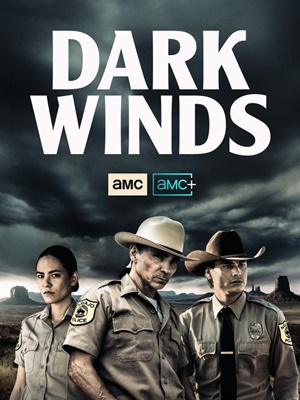 So, I wrote a three-part series, covering about 5,000 words, on Tony Hillerman and his Navajo Tribal Police series. I said this at the end of the third one: “Somewhere down the line, there will be a post about the four movies (and several failed attempts at such) made from these books.”
So, I wrote a three-part series, covering about 5,000 words, on Tony Hillerman and his Navajo Tribal Police series. I said this at the end of the third one: “Somewhere down the line, there will be a post about the four movies (and several failed attempts at such) made from these books.”
Back in July of 2021, I wrote this essay, optimistically excited about AMC’s upcoming series based on Hillerman’s books.
The six-episode series aired back in June, but I just got around to watching it. So, this seems like a good time to write a fourth-installment in my Hillerman series, talking about Dark Winds.
If you want to know more about Hillerman and the books, click on the link above. You can find all three essays. I’m a HUUUUGE fan of his books.
I am not a fan of the continuation novels written by his daughter, Anne.
Dark Winds is set in the seventies, on the reservation in Four Corners country. That’s where Hillerman’s Leaphorn and Chee police procedurals take place. Joe Leaphorn is the boss of this Navajo Tribal Police sub-station. Bernie Manuelito is his number two. Jim Chee is a young officer newly assigned there. These are the three main characters in the books,and in the series.
THE STORY
Season One’s story is based on Listening Woman; the third book in the series. They use enough of the basics to recognize the source material – though they definitely change things up a fair amount. And Hillerman didn’t create Chee until book four. Or Bernie until book six. But it makes sense to have all three in the series: it all works. Listening Woman is a good novel, and I think, the best of the first three. So, a good choice to start the series with. They also worked in elements from book four, People of Darkness, which is one of my favorites. Nice!
SPOILER ALERT – The book is 44 years old. The series aired in June. I’m not gonna reveal everything, but there are definitely spoilers to follow. Read the book, or watch the series. Best option is to do both. – END SPOILER ALERT
The show opens with a brutal armored car robbery. And not the typical ‘Ram it with a dump truck’ approach. These guys rob in style, flying away in a helicopter. We see an older Native American watch it fly overhead as it heads into Navajo territory.
That man, Hosteen Tso, gets sick after that, and later is seeing a healer in a motel room. The healer, who is blind, is The Listening Woman of the book’s title. She is aided by her pretty young granddaughter, Anna Atcitty.
The healing ceremony (which is identified as a ‘Sing,’ but is nothing like the elaborate ceremony which Hillerman described in multiple books) jumps forward to Leaphorn, who was called to the hotel. It’s dark, rainy, and very atmospheric. He finds: Listening Woman sitting in the lobby, in a state of shock, but unharmed; Tso dead, his eyes gone; and Ana dead in the bathtub.
So, we have an armored car robbery and a gruesome murder, ‘witnessed’ by a blind woman. There is your main story line for the first season. Both events are from the book, which is cool.
GOOD SHOW: BAD HILLERMAN
The pieces are in place. Dark Winds is a good series. I liked it, and I’m looking forward to season two. Sadly, what it is not, is it’s not very Hillerman. It’s a much more watchable book adaptation than Amazon’s big-budget Tolkien fan fiction, The Rings of Power. But as far as Hillerman goes, it’s a disappointment. Especially since Hlilerman fans (Robert Redford, George R.R. Martin) were behind it.
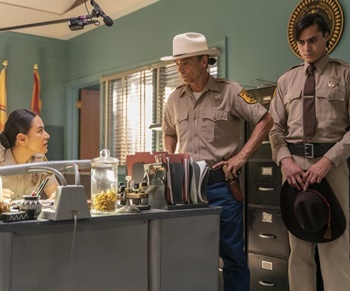 And that disappointment is rooted in the three main characters.
And that disappointment is rooted in the three main characters.
The only thing Chee and Manuelito have in common with Hillerman’s books are their names. They could have called them Franklin Tsosi and Melissa Garcia, and nothing would have changed. Leaphorn at least has some of Hillerman’s creation in him, though not a preponderance.
The three PBS movies made around 2000 are far more faithful to Hillerman than this series. Heck – the pleasant but forgettable The Dark Wind (starring a young Lou Diamond Philips) is more Hillerman than this show.
And that’s what makes this a good cop show, but a disappointing Hillerman adaptation
If you’re gonna use a book, then change the characters completely, you’re really just paying for the plot, and to cash in on the best-selling author’s name, right? And since Hillerman’s daughter is an executive producer (she gave her blessing), you’d like to think it would be truer to his works.
Having said that, in her continuation novels she reshaped her father’s series to be what she wanted it to be – not build on her father’s series. So, expecting authenticity from her corner is probably unreasonable. And my take is that she is writing her novels to specifically target female readers. It’s more of a Lifetime cop series than her father’s Navajo Tribal Police series (and it’s now officially the ‘Leaphorn, Chee, and Manuelito’ series. Might as well call them ‘Bernie Manuelito Mysteries’). But she sells a lot more books with Bernie, Chee, and Leaphorn in them, than she would have with an entirely new series.
I started Stargazer (book six) this week, and it’s more of the same. This is from chapter three:
“It was Sunday, her last shift on patrol before she switched from Officer Bernadette Manuelito, to focus more closely on her role as momma’s eldest daughter, and Darlene’s big sister.”
It’s typical of the complete transformation of her father’s series, and why reading her books is very little like reading Tony Hillerman’s books. So, as far as ‘Hillerman Quality Control’ goes, she wouldn’t have been a great choice. I hoped for more from Redford and Martin, though. Maybe they just lent their names to the project.
The production filmed in reservation country, and the cast is predominantly Native American. It’s perplexing why a series that worked so diligently to make it a culturally intensive production in practically all areas, wasn’t interested in actually utilizing Hillerman’s characters. I’m not upset – just genuinely puzzled.
JIM CHEE
After showing us the murder scene, Chee, a cocky young officer, just assigned from Tuba City, is introduced at the station, meeting Leaphorn and Manuelito.
Kiowa Gordon is Chee. I think he does a good job with the part as written. But he’s nothing like Jim Chee in the books. From my Chee essay (the third one):
Chee is constantly in conflict. On a professional level, he is trying to reconcile being a policeman with becoming a singer (in Navajo, a ‘yataali’). Singers are akin to shamans, or medicine men. They perform elaborate rituals, involving complex sand paintings, that cure what ails a Navajo and brings them back into harmony and balance. There are fewer and fewer singers as the younger Navajos leave behind the old ways and Chee wants to become one. Leaphorn thinks it’s a ridiculous combination and can’t be done.
This is literally the heart of Chee. It is the core of his character. You take that out, and what you’ve got left is no more Jim Chee, than I am. And the show totally eliminated it. Other than a mention that his uncle was a healer (Frank Sam Nakai in the books, and a father figure to Chee), it’s totally wiped from the series.
So fundamentally, Chee isn’t Chee. That’s a bummer. SPOILER SPOILER (seriously, it’s a big one). My jaw was left hanging down when it was revealed that Chee is actually an undercover FBI agent. Are you friggin’ kidding me? That is pure teen-level fan fiction. I’d be embarrassed to include that if I were writing a Chee story.
It is literally one of the most ludicrous things I’ve run across in a TV show the past couple years. I’d put it up there with finding out that Sam Gamgee was really working as an agent of Sauron. It’s that far afield. You could simply have eliminated Chee from the script and used a different character entirely.
In the books, Chee is accepted to the FBI Academy (he is trying to make a life that works for a white school teacher he’s engaged to), but he just can’t become ‘an assimilated Indian.’ He can’t leave the reservation and work in the white man’s world of law enforcement. He rejects the Academy (and loses his fiancee). That’s how ridiculous having Chee be a career-driven FBI agent is.
I can actually picture a SNL-type parody skit, where they’re sitting around a writer’s table, trying to come up with more and more outlandish things for the series. “I’ve got it! We’ll make Chee undercover FBI!” That absolutely fits in. Tony Hillerman would have laughed at the idea.
So, they completely gutted Jim Chee, and he has nothing to do with Hillerman’s creation. Why?
BERNIE MANUELITO
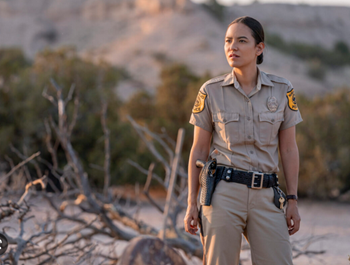 Bernie underwent a complete personality transformation. In the books, she is an unsure, quiet, young officer trying to feel her way through the job. Being a woman, and relatively inexperienced, along with naturally shy, forms her persona.
Bernie underwent a complete personality transformation. In the books, she is an unsure, quiet, young officer trying to feel her way through the job. Being a woman, and relatively inexperienced, along with naturally shy, forms her persona.
Not here. Jessica Matten plays a typical, hard-edged female cop, seen in every big-city police show on TV. She’s a knowing, smart-ass to Chee from the start. She’s the generic blueprint for a female TV cop today.
Again – why the need to completely gut the character? It’s like they felt it wasn’t acceptable to have a female cop who is anything but assertive and overtly tough (Bernie’s inner toughness coming out is a key part of her development in the books). As with Chee, the only thing Bernie has in common with Hillerman’s creation is the name.
There was one scene, at a coming of age ceremony, where her shyness actually reminded me of the books. It’s a fleeting moment, and a unique one.
JOE LEAPHORN
Zahn McClarnon is Joe Leaphorn – the center of the series. McClarnon was terrific in Longmire, and I was happy to see him cast in the part. Wes Studi (a Cherokee) had been solid as Leaphorn in the PBS movies, but there was definitely room for a memorable performance here. I don’t think that Fred Ward (The Dark Wind movie) was anybody’s picture of Leaphorn.
McClarnon is a terrific actor (so is Studi), and he’s excellent. I think he should win some awards for his performance. And they didn’t completely throw out Hillerman’s character for the series. On the other hand, they didn’t really dig in very deeply to Leaphorn’s core, but maybe in season two.
I wrote this about Leaphorn in essay two:
Leaphorn is a methodical man and Hillerman combines this with the Navajo concept of hozho (the concept of walking in balance in the world – maintaining harmony). In The Blessing Way, Hillerman writes,
“That would have been luck. Leaphorn never counted on luck. Instead, he expected order – the natural sequence of behavior, the cause producing the natural effect, the human behaving in the way it was natural for him to behave.
He counted on that and upon his own ability to sort out the chaos of observed facts and find in them this natural order…and it was a talent which caused him, when the facts refused to fall into the pattern demanded by nature and the Navajo Way, acute mental discomfort.”
For me, this sense of order and logical consistency is exemplified by the Indian Country Map tacked up on the wall of his office. It’s from the Southern California Auto Club. It has up to a hundred colored pins spread out, representing different types of crimes throughout the reservations. He looks for clusters and linkages to help him think through problems. The other policemen think it’s a sign of eccentricity, but it’s a visual depiction of Leaphorn’s thought process.
And this, actually from Listening Woman:
Again, we learn of Leaphorn’s belief in the pattern of things:
“Too much coincidence. Leaphorn didn’t believe in it. He believed nothing happened without cause. Everything intermeshed, from the mood of a man, to the flight of the corn beetle, to the music of the wind. It was the Navajo philosophy, this concept of interwoven harmony, and it was bred into Joe Leaphorn’s bones.”
Earlier in Listening Woman, when Captain Largo tells Leaphorn the killings don’t make any sense:
“There had to be sense to it. A reason. It had to fit some pattern of cause and effect. Lephorn’s sense of order insisted on this. And if the cause happened to be insane by normal human terms, Leaphorn’s intellect would then hunt for harmony in the kaleidoscopic reality of insanity.”
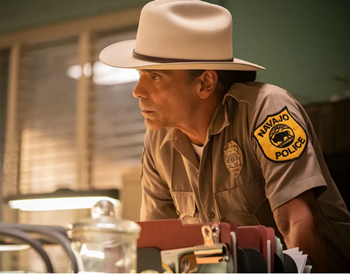 Chee makes an almost offhand comment about Leaphorn connecting things, as they get out of a police vehicle, but that’s about it. They didn’t completely transform Leaphorn’s core, they simply ignored it.Imagine if they tossed out deductive reasoning for Sherlock Holmes. Or The Force for Luke Skywalker. It’s Leaphorn’s compass as a police officer.
Chee makes an almost offhand comment about Leaphorn connecting things, as they get out of a police vehicle, but that’s about it. They didn’t completely transform Leaphorn’s core, they simply ignored it.Imagine if they tossed out deductive reasoning for Sherlock Holmes. Or The Force for Luke Skywalker. It’s Leaphorn’s compass as a police officer.
I remain puzzled by this seeming determination to move away from Hillerman. Why? There’s still time in future seasons, of course. But it certainly wasn’t an integral part of Leaphorn so far. And since they abandoned Chee and Manuelito, I’m not expecting them to draw more on Hillerman for this. We’ll see.
SPOILER (I mean, do I need to even warn you at this point?). Leaphorn and Emma did not have any children in the books. Whereas, in the series, Joe Jr. had died in an oil field explosion.
The oil rig explosion is from the fourth book, People of Darkness. That was the first book with Chee, and Leaphorn wasn’t in it at all. It’s the most ‘hardboiled private eye-type’ book of the series, and one of my favorites. I love that they worked it into season one. Kudos! Dillon Charley (He was a good Indian) even gets a flashback appearance.
In the books, Emma dies of a brain tumor between the end of Skinwalkers and the beginning of A Thief of Time. I’m hoping they don’t kill her off in the series, as I quite like Deanna Allison’s portrayal. And I liked Emma in the books and didn’t want her to die there. It does seem that the series has taken some of Leaphorn’s grief over Emma’s death in the books, and moved it to grief over the loss of Joe Jr.
It’s rather tenuous, and pretty much made up however they wanted, but it works. And it makes them having a dead son not as jarring to a Hillerman reader.
Joe Jr. also had a girlfriend who is part of season one, so it deepens Leaphorn’s emotional stake in the case. The Joe Jr. ‘story’ is woven deeply into the plot, and it forms the key aspect of Leaphorn and Emma’s relationship. I don’t mind the addition.
THE FEDS
Now, it’s a common trope in police shows for the feds to be jerks. They come in, cut out the locals, and act like imperious jackasses. That may well be a fairly accurate reflection of real life. But it’s a tiresome depiction when you’ve seen it a hundred times.
In the books, Leaphorn actually gets along fairly well with the Special Agent in Charge of the moment, who is assigned to the area. The Arizona/New Mexico field office is an FBI equivalent of Siberia, and the opposite of a choice assignment. Perhaps that feeds into the SAC usually being a reasonable human being. It’s not some young, career-hungry ladder-climber.
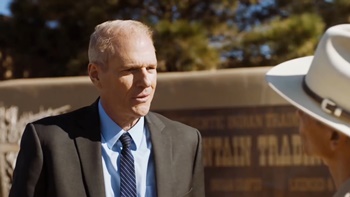 Now, the Feds do get ‘We’re in charge’ when the stakes are high. An armored car robbery, with a couple dead guards, can be a big deal. They remain interested in the case, even though the helicopter seems to have vanished in Navajo country and seems like a cold case. There’s a casino robbery, with deaths, in Hunting Badger: that’s another Fed-heavy book. As is The Dark Wind.
Now, the Feds do get ‘We’re in charge’ when the stakes are high. An armored car robbery, with a couple dead guards, can be a big deal. They remain interested in the case, even though the helicopter seems to have vanished in Navajo country and seems like a cold case. There’s a casino robbery, with deaths, in Hunting Badger: that’s another Fed-heavy book. As is The Dark Wind.
Here, Noah Emmerich is FBI Agent Whitover (sarcastically called ‘High Pockets’ by Leaphorn). I didn’t see The Americans, but he was in every episode. He was good as an unlikeable FBI agent in White Collar (great show: mix of Leverage and Burn Notice). He also co-starred in Windtalkers with Adam Beach, who played Chee in the PBS movies.
I think he’s excellent here. Like just about any other FBI agent not at the end of his career, he doesn’t want to be out there in the Southwest. He’s the one who has Chee working undercover at the Tribal Police. If he can break the armored car robbery case, he will get a plum assignment (DC is mentioned several times), and he promises to take Chee with him.
SPOILER – The blind woman makes a cryptic comment about people not being who they appear to be. And in the scene, it can be taken as a warning to Leaphorn about Chee (not yet revealed as FBI). But it could apply to Whitover, as well.
Whitover’s story in this series has nothing to do with the book, other than being the FBI guy in charge. Since he was a minor character in the book, and they were going to jigger with the plot details, it didn’t really matter to me that they greatly expanded his role. Unlike Chee and Bernie, he wasn’t going to be a recurring character. They actually made the book’s villain less memorable and less fully fleshed out, with the changes here to Whitover. But no big deal, all in all.
CULTURAL PERSPECTIVE
There’s something that pervades the early books and I think remains throughout the series (I’m on book seven of this re-read). Hillerman presents the dichotomy between the way white people think and Navajos think. It presents an obstacle that the Indian policemen must overcome to solve the crime.
A Navajo would never murder for gain. But that’s certainly a part of the mainstream culture. And Leaphorn and Chee have to consider this, even though it’s an alien concept to them and something they struggle to understand. Kind of a ‘Stranger in a Strange Land’ phenomenon, even though it’s usually their land.
That’s from essay two. Hillerman weaves this into how Leaphorn (and to a lesser extent, Chee), approaches his job. He has Navajo values – not the values of the white man. Even though he was raised in a boarding school, to be indoctrinated into white culture. The show has Leaphorn reveal this, and it’s a nice inclusion. Another part of immersing the viewer in the culture – without long, windy scenes underpinning it.
I like that this show incorporates some cultural concepts, without belaboring, or digging into explaining them. The inclusion enriches the show, but it doesn’t constantly slow things down, elaborating on them. And in this internet age, the interested viewer can go look something up. You’re probably gonna look up ‘Kinaalda’ thanks to this show.
This differing perspective is subtly and deftly handled in a scene where Leaphorn and Whitover are talking. Whitover is focused on the robbery; Leaphorn specifically addresses the murders. It’s integral to how each man views his job. And how each looks at life. The show did well, working this scene and element in.
The FBI man wants to find the robbers, recover the loot, and get the heck out of New Mexico. He couldn’t care less about two dead Indians. He even refers to the girl as a hooker or tramp, a couple times. This angers Leaphorn.
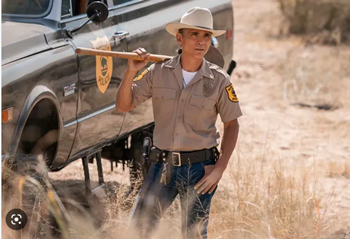 At the end, when Whitover asks how Leaphorn knows the robbers were white men, Leaphorn tells him that he’ll consider that the robbers were Native Americans, if he’ll treat the murder victims as if they were white. It’s a strong statement to define their perspectives.
At the end, when Whitover asks how Leaphorn knows the robbers were white men, Leaphorn tells him that he’ll consider that the robbers were Native Americans, if he’ll treat the murder victims as if they were white. It’s a strong statement to define their perspectives.
Leaphorn wants to solve the murders and bring some closure to the families. His son’s death is tied in to the girl’s father, and Leaphorn has a history with the man. As he says, some people think he’s too close to it.
Whitover dismissively tells Leaphorn that the families can claim Tso’s and Anna’s bodies. Leaphorn says they don’t have the means for that. Whitover doesn’t care, and tells him that Leaphorn can do it for them, or the bodies will be turned over the State. Presumably to go in a pauper’s grave. He’s totally callous and indifferent.
Leaphorn buys a pair of large rugs and delivers the bodies himself. When Tso’s grandson (a local priest) isn’t home, Leaphorn actually buries the body himself. It’s another total contrast between the values and cultures of the two lawmen.
Leaphorn and Whitover are both law enforcement officers. They are both trying to solve deadly crimes. But their motivations, and their focuses (foci?), are completely different. And they are shaped by their cultural upbringing and worldview. I’m glad the show worked this in. It’s an important part of Hillerman’s books.
WITCHCRAFT
Man, I do like quoting myself! Essay two again:
Witchcraft is a common theme in the stories and is deftly handled. Suspicion of witches (not the “double double, toil and trouble” kind) as the source of trouble is something Leaphorn commonly runs into. Though he was raised as a traditional Navajo, he stopped believing in witches while at college. Now, Leaphorn believes in evil. But his dismissal of witches in an early case led to deaths and he learned not to discount the belief of others in them while investigating a case.
In the books, Emma is a traditionalist, while Leaphorn doesn’t believe in the supernatural. It’s another layer of their relationship.
In the books, violence and evil arise from the belief in witches. Such an incident was a cornerstone in Leaphorn’s development as a police officer, as told in A Thief of Time. People in the stories are convinced they have encountered witches, though it’s never established definitively through Leaphorn. Witchcraft is certainly real in Dark Winds, though. One of the main characters is a witch, and she becomes the center of Bernie’s sub-story.
In the books, Chee and Bernie both believe in the supernatural (obviously in his case, since he’s studying to be a singer). There are Navajo taboos against being near a dead body. Chee runs up against it often in the novels. Dark Winds makes witchcraft a very real thing, but really limits it to Bernie’s story. It is largely discounted as an element in Navajo life, or in the Tribal Police doing their jobs.
Dark Winds has a noir feel to it, and the witch element adds a supernatural aspect, which works. I was kinda hoping to see someone shoot a witch with a bone bead
LESTER
As I’ve shown, the show is a mix of good and bad. And most of the bad is their disregard of Hillerman’s actual characters. Here’s another instance.
Another totally unnecessary change was in the store owner, Lester. In the books, Shorty McGinnis is a crotchety old white man, running a trading post out in the boonies. He is in a three books, and he’s one of my favorite supporting characters. He is a source of gossip, information and cynical insights. I can still picture him filling up up a coke glass to a specific point, with bourbon. It’s a very clear picture. Hillerman created a memorable character.
In what I can only see as a nod to diversity (which is kinda funny, because there are only a few caucasians, and none are portrayed flatteringly), he’s transformed into a less old, and way less cranky, African American. He’s even flip.
No relationship whatsoever to Hillerman’s character. Who, as I mentioned, was a favorite of mine. Another unneeded change that doesn’t improve anything, since Hillerman’s character was better, and nothing was gained by transforming him. I was looking forward to Shorty McGinnis being an occasional character in the show. Nope.
THE BIGGER PICTURE
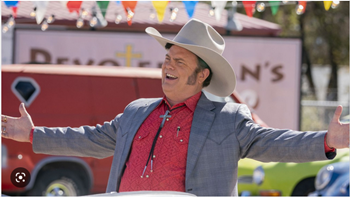 The show does a good job of piece-work reveals, moving the plot forward with more information, step-by-step. The bank robbery ties into a money laundering scheme. People are being killed to cover up the robbery and the money laundering. Multiple people definitely aren’t who they pretend to be, as Listening Woman cautioned.
The show does a good job of piece-work reveals, moving the plot forward with more information, step-by-step. The bank robbery ties into a money laundering scheme. People are being killed to cover up the robbery and the money laundering. Multiple people definitely aren’t who they pretend to be, as Listening Woman cautioned.
Rainn Wilson (Dwight in The Office) is a hypocritical, holy roller car salesman. The part isn’t given undue emphasis, but Wilson is great in it. He is blackmailed into laundering the money. In an interview, Wilson said he was a fan of the PBS movies, which one of his acting school friends had been in. He got a point from me for that!
Honestly, I didn’t figure everything out the first time through, and I watched it all a second time to tighten up this essay. Leaphorn is partly driven to solve the crime because it ties into the death of his son. So, he has an emotional and professional stake in it.
Chee and Whitover need it solved to get off the reservation.
Two of the three robbers are members of the Buffalo Society (a militant Native American movement) and are driven by their beliefs.
There are a lot of disparate elements which gradually come together with a sense of increasing tension. The show weaves a tangled skein, which it untangles into a coherent picture.
CHEE’S GROWTH
I found this show so enjoyable to watch, I immediately did a re-watch. One thing I put together, which didn’t quite register the first time, was about Chee passing broken-down cars on the road (what passes for a highway in the series). Out on the reservation, it’s not like you just walk to the next off-ramp and take care of things. And you might not have a car even pass you for hours. There are no cell phones in 1971 – breaking down can be a very serious event.
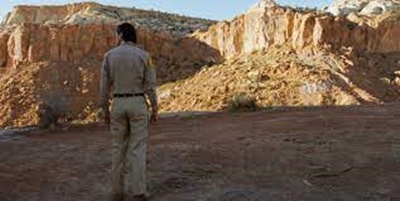 Early in episode one, our first depiction of Chee is as a well-dressed, young dude zipping down the highway. It’s a nice El Camino (clearly not Hillerman’s Chee), and ‘Born to be Wild’ is playing. He flies by a family which broke down on the roadside. This was so early in the first episode, my first thought was, “Chee wouldn’t just ignore them like that.” So, I was a bit wary of the Chee depiction already.
Early in episode one, our first depiction of Chee is as a well-dressed, young dude zipping down the highway. It’s a nice El Camino (clearly not Hillerman’s Chee), and ‘Born to be Wild’ is playing. He flies by a family which broke down on the roadside. This was so early in the first episode, my first thought was, “Chee wouldn’t just ignore them like that.” So, I was a bit wary of the Chee depiction already.
But later, he does stop to help an old man whose beater vehicle has broken down in a similar situation. Chee is polite and helpful, and the man provides him with information which helps solve the whole case.
It’s a nicely done bit that shows Chee’s growth as a character during season one. He tells Whitover, “Anywhere but here”: he wants off the reservation that badly. That goes along with his ignoring the family in need.
But as the season progresses, he does have a character arc; albeit an incomplete, slowly developing one. His stopping to help shows he is developing ties to the reservation, and his Navajo background (his mom had been unfairly driven off the reservation by a false witchcraft accusation when Chee was little). And, his ‘good action’ is rewarded with a clue. I like this.
SO…….
It’s a noir-like crime drama; with emotional and professional drives for the characters; a deep immersion in Navajo culture; terrific scenery; solid cast; and a complex plot. If you completely ignore that it’s supposed to be a Tony Hillerman series, I rate it an A-.
Just as I enjoyed Johnny Lee Miller’s Elementary as a police procedural with a Sherlock Holmes overlay, Dark Winds is a nice crime series using the plot of a Tony Hillerman novel. As a series actually using Hillerman’s characters, it falls woefully short. The three PBS movies are much better Hillerman works.
But it’s good enough for me. Unlike Rings of Power, where Amazon spent a half-billion dollars to water down Tolkien into teenage fan fiction, Dark Winds is a six episode cop drama that uses Hillerman’s plot and setting, if not his characters. And while one episode of Rings of Power seemed to take forever to get through, I found myself surprised to ‘already’ be at the end of a Dark Winds installment.
I expected more Hillerman, but it’s still a really good series, well worth a watch. For some reason, the first episode is on Amazon Prime, while the remaining five are on AMC. That first episode is not on AMC, so go find it on Prime.
I wonder what book they’ll use for season two’s plot? A Thief of Time would be terrific (they already used that for the PBS series, though). Sacred Clowns has a really exciting finale. The Wailing Wind was neat, but didn’t have any supernatural element, as I recall. The Ghostway was good, and had one of the series’ most memorable villains.
Lots of good options, since it’s a terrific series.
ENJOY IT
You can simply watch the show, and it’s very good. You should enjoy it. That’s fine. In looking at it as an intellectual property, licensed and adapted, there’s another layer, in which you ask, “Is it good Hillerman?”
I love the books. I quite like this show. But it did not bring Leaphorn, Chee, and Bernie, from the page to the screen. They aren’t Hillerman’s characters. So, in that regard, it’s not as good Hillerman as the PBS movies. Thus, good, but disappointing. Zach McClarnon is really outstanding, even though he’s not so much Leaphorn. I choose to view this show as seventies cop drama set on an Indian reservation. And it borrowed from a Tony Hillerman book for the plot. And in that regard, it’s a heck of a six-episode show.
This is definitely worth watching, but it’s not the definitive Tony Hillerman series. Go read the books and see what I mean They could have changed a lot, and made a crappy show. THAT would have been a wasted opportunity. Fortunately, they didn’t turn adapting Listening Woman into the train wreck Hollywood turned the adaptation of Lawrence Block’s Burglar series. Thank goodness they quit at one.
And regarding the changes, as James M. Cain said, “They haven’t done anything to my book. It’s right there on the shelf.”
TONY HILLERMAN HERE AT BLACK GATE:
Part One – Meet Tony Hillerman
Part Two – The Navajo Sherlock Holmes
Part Three – Enter Jim Chee
AMC Might do Justice to Tony Hillerman’s Books
 Bob Byrne’s ‘A (Black) Gat in the Hand’ made its Black Gate debut in 2018 and has returned every summer since.
Bob Byrne’s ‘A (Black) Gat in the Hand’ made its Black Gate debut in 2018 and has returned every summer since.
His ‘The Public Life of Sherlock Holmes’ column ran every Monday morning at Black Gate from March, 2014 through March, 2017. And he irregularly posts on Rex Stout’s gargantuan detective in ‘Nero Wolfe’s Brownstone.’ He is a member of the Praed Street Irregulars, founded www.SolarPons.com (the only website dedicated to the ‘Sherlock Holmes of Praed Street’) and blogs about Holmes and other mystery matters at Almost Holmes.
He organized Black Gate’s award-nominated ‘Discovering Robert E. Howard’ series, as well as the award-winning ‘Hither Came Conan’ series.
He has contributed stories to The MX Book of New Sherlock Holmes Stories – Parts III, IV, V, VI and XXI.
He has written introductions for Steeger Books, and appeared in several magazines, including Black Mask, Sherlock Holmes Mystery Magazine, The Strand Magazine, and Sherlock Magazine.
I’m probably going to hold this up as an example of how an adaptation can not be true to the source material, but still be a quality production in and of itself.
This FAR outshines Amazon’s Rings of Power in that regard.
It’s light years better as an end product.
The headline got it right. It’s a pretty good TV show but has only a vague relation to the books. The show would have been better if they had picked the names out of the Navajo phone book. As a fan of the books, I constantly caught myself thinking, “Emma? But Emma had cancer and died.” “Chee was never a private eye.” “Where’s the wide shot of the landmark Shiprock? Shiprock’s almost a character in the Hillerman books.”
Enjoyed your article, thank you. I read the Hillerman books long ago..maybe in the 80’s? Because I’m 70 and read so many novels and watched so many detective shows, I easily forget the plots. I recently tried reading one of the Hillerman books, but couldn’t get past the first chapter. I was probably reading his daughter’s books without realizing it and wondered why I didn’t like it–I’ll have to go back and check.
ANYWAY, I totally agree with what you’re saying. I, too, was a bit confused with the characters and plot. I don’t recall so much violence in Hillerman’s books. I did enjoy Bernadette’s role, but yes, couldn’t recall this dominant character. Throughout the series I kept wondering why the male officers kept failing and she seemed to be pulling them out of trouble. Nice, but not keeping to the books. Leaphorn seemed to make bad choices.
As I said, I’m a big fan of detective books and shows. Why on earth do so many of the male detectives lose their wives? It’s ridiculous. I guess writers love that macho cop with deep brooding sadness that drives him. So overdone. I hope they don’t kill off Emma.
What I didn’t understand was exactly why Hosteen had his eyes removed.
Another annoyance: how on earth did no one wonder why those paintings were so HEAVY with all that money inside?! It seemed like such a dopey way to “launder money,” or am I missing something?
Anyway, thank you for letting me vent!
So glad to have found your comments. I believe I read all the Hillerman books and although it was years ago,The show just didn’t seem like a good depiction of Chee, a character I loved. And it seemed to me the timeline and story was mixed up. i did like the first Anne Hillerman book but after that I said, Nah. They just weren’t as good. Thank you for making me realize I wasn’t crazy.